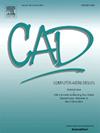Prototype optimization and self-training for few-shot 3D point cloud semantic segmentation
IF 3.1
3区 计算机科学
Q2 COMPUTER SCIENCE, SOFTWARE ENGINEERING
引用次数: 0
Abstract
Few-shot point cloud segmentation aims to accurately decompose 3D point clouds into different semantic classes with few samples, and is crucial for subsequent tasks, such as analysis, modeling and editing. Despite the popularity of prototype-based approaches, prototypes often fail to adequately capture class-specific information. Therefore, for each class, a few points may exhibit significant differences from their prototype. And the lack of sufficient distinction between foreground and background prototypes presents a great challenge for precise segmentation. To address these issues, we propose a prototype optimization module to mitigate the interference among support prototypes, thereby generating prototypes of superior quality. These refined prototypes are capable of capturing the key characteristics of the data, which can prominently improve the generalization capability of our model. Then, we devise a self-training strategy that leverages pseudo query prototypes generated from high-confidence predicted labels. These prototypes are applied to query features to produce pseudo query labels and formulate a reconstruction constraint during training. By harnessing the contextual information embedded within query features, this approach significantly elevates segmentation performance. Extensive results on two popular benchmark datasets validate the superiority of our model, especially in the challenging 1-shot settings. Under the classic experimental setup, our method surpasses existing state-of-the-arts by 2.64% in 2-way 1-shot setting on the S3DIS dataset. On the ScanNet dataset, the improvements are 7.58% in 2-way 1-shot setting and 6.44% in 3-way 1-shot setting, respectively.
少镜头三维点云语义分割的原型优化与自训练
少镜头点云分割旨在用较少的样本将三维点云准确分解为不同的语义类,对后续的分析、建模和编辑等任务至关重要。尽管基于原型的方法很流行,但原型常常不能充分捕获特定于类的信息。因此,对于每个类,可能会有一些点与其原型有显著差异。前景和背景原型之间缺乏足够的区分,这给精确分割带来了很大的挑战。为了解决这些问题,我们提出了一个原型优化模块,以减轻支持原型之间的干扰,从而产生高质量的原型。这些精细化的原型能够捕获数据的关键特征,这可以显著提高我们模型的泛化能力。然后,我们设计了一种自我训练策略,利用高置信度预测标签生成的伪查询原型。将这些原型应用于查询特征,生成伪查询标签,并在训练过程中形成重构约束。通过利用嵌入在查询特征中的上下文信息,这种方法显著提高了分割性能。在两个流行的基准数据集上的广泛结果验证了我们模型的优越性,特别是在具有挑战性的1次射击设置中。在经典的实验设置下,我们的方法在S3DIS数据集上的2-way 1-shot设置比现有的最先进的方法高出2.64%。在ScanNet数据集上,2-way 1-shot设置的改进率为7.58%,3-way 1-shot设置的改进率为6.44%。
本文章由计算机程序翻译,如有差异,请以英文原文为准。
求助全文
约1分钟内获得全文
求助全文
来源期刊

Computer-Aided Design
工程技术-计算机:软件工程
CiteScore
5.50
自引率
4.70%
发文量
117
审稿时长
4.2 months
期刊介绍:
Computer-Aided Design is a leading international journal that provides academia and industry with key papers on research and developments in the application of computers to design.
Computer-Aided Design invites papers reporting new research, as well as novel or particularly significant applications, within a wide range of topics, spanning all stages of design process from concept creation to manufacture and beyond.
 求助内容:
求助内容: 应助结果提醒方式:
应助结果提醒方式:


